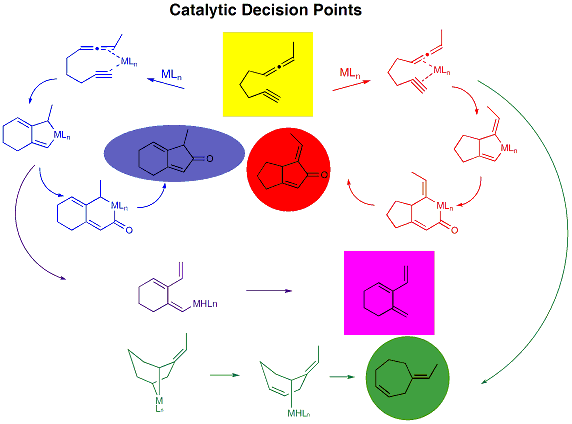
|
|
<Back |
|||
|
|
|
Catalytic Decision Points and Reaction DiscoveryThe ability to put together complex molecules, like piecing together a puzzle, is a challenging endeavor since the skills required to accomplish this are as much artistic as scientific. My group enjoys thinking about and discovering new ways to assemble the atoms that complex molecules are made from. Once a new method has been identified in the laboratory, experiments are designed and performed to test and validate them for their robustness and utility. We
have
demonstrated that transition metal catalyzed processes can be
intercepted at
various stages of the catalytic cycle “catalytic decision points” to
provide
structurally unique and different compounds depending upon the point of
interception. This diverging strategy is not typically been exploited
in the
chemistry laboratory but is one that is adopted by nature in the
assembly of
secondary metabolites, more commonly referred to as natural products. 
The
new
reactions are then used in our group to synthesize collections or
libraries of
previously unknown compounds. Once synthesized, the compounds are
tested for
their biological activity by researchers at the In addition to preparing entirely new compounds, we also use the new methods discovered in our group to synthesize compounds in which their biological significance has already been established. The goal of these efforts is provide faster, more efficient and innovative means of accessing these structures. For example, these new methods have been successfully applied to the synthesis of HMAF, a potent anticancer compound currently in Phase III clinical trials and 15-deoxy-D12,14 PGJ2, a cyclopentenone prostaglandin that is a natural ligand for PPAR, a receptor linked to type II diabetes and obesity and FR901483, a compound possessing immunosuppressive activity. Ongoing projects include the synthesis of guanacastepene, isolated recently and shown to exhibit excellent activity against vancomycin resistant bacteria and suberosenone, possesses differential cytotoxicity in human tumor cell-lines. The students involved with these projects are uniquely suited to go on to work in the pharmaceutical industry where they will strive to discover and develop new drugs. |
|
|
|